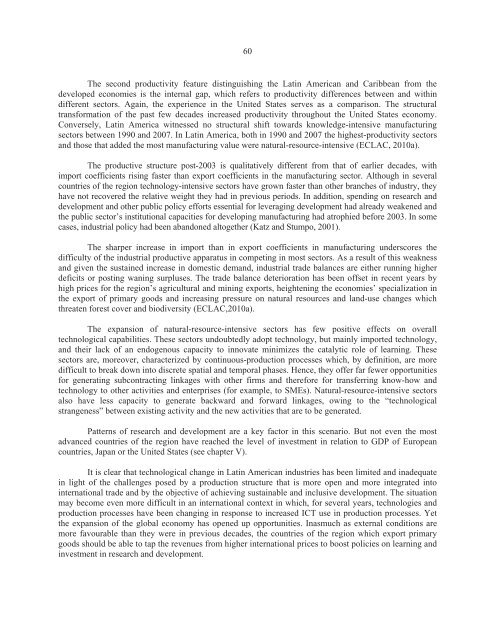sustainable development 20 years on from the ... - José Eli da Veiga
sustainable development 20 years on from the ... - José Eli da Veiga
sustainable development 20 years on from the ... - José Eli da Veiga
Create successful ePaper yourself
Turn your PDF publications into a flip-book with our unique Google optimized e-Paper software.
60<br />
The sec<strong>on</strong>d productivity feature distinguishing <strong>the</strong> Latin American and Caribbean <strong>from</strong> <strong>the</strong><br />
developed ec<strong>on</strong>omies is <strong>the</strong> internal gap, which refers to productivity differences between and within<br />
different sectors. Again, <strong>the</strong> experience in <strong>the</strong> United States serves as a comparis<strong>on</strong>. The structural<br />
transformati<strong>on</strong> of <strong>the</strong> past few decades increased productivity throughout <strong>the</strong> United States ec<strong>on</strong>omy.<br />
C<strong>on</strong>versely, Latin America witnessed no structural shift towards knowledge-intensive manufacturing<br />
sectors between 1990 and <str<strong>on</strong>g>20</str<strong>on</strong>g>07. In Latin America, both in 1990 and <str<strong>on</strong>g>20</str<strong>on</strong>g>07 <strong>the</strong> highest-productivity sectors<br />
and those that added <strong>the</strong> most manufacturing value were natural-resource-intensive (ECLAC, <str<strong>on</strong>g>20</str<strong>on</strong>g>10a).<br />
The productive structure post-<str<strong>on</strong>g>20</str<strong>on</strong>g>03 is qualitatively different <strong>from</strong> that of earlier decades, with<br />
import coefficients rising faster than export coefficients in <strong>the</strong> manufacturing sector. Although in several<br />
countries of <strong>the</strong> regi<strong>on</strong> technology-intensive sectors have grown faster than o<strong>the</strong>r branches of industry, <strong>the</strong>y<br />
have not recovered <strong>the</strong> relative weight <strong>the</strong>y had in previous periods. In additi<strong>on</strong>, spending <strong>on</strong> research and<br />
<str<strong>on</strong>g>development</str<strong>on</strong>g> and o<strong>the</strong>r public policy efforts essential for leveraging <str<strong>on</strong>g>development</str<strong>on</strong>g> had already weakened and<br />
<strong>the</strong> public sector’s instituti<strong>on</strong>al capacities for developing manufacturing had atrophied before <str<strong>on</strong>g>20</str<strong>on</strong>g>03. In some<br />
cases, industrial policy had been aband<strong>on</strong>ed altoge<strong>the</strong>r (Katz and Stumpo, <str<strong>on</strong>g>20</str<strong>on</strong>g>01).<br />
The sharper increase in import than in export coefficients in manufacturing underscores <strong>the</strong><br />
difficulty of <strong>the</strong> industrial productive apparatus in competing in most sectors. As a result of this weakness<br />
and given <strong>the</strong> sustained increase in domestic demand, industrial trade balances are ei<strong>the</strong>r running higher<br />
deficits or posting waning surpluses. The trade balance deteriorati<strong>on</strong> has been offset in recent <str<strong>on</strong>g>years</str<strong>on</strong>g> by<br />
high prices for <strong>the</strong> regi<strong>on</strong>’s agricultural and mining exports, heightening <strong>the</strong> ec<strong>on</strong>omies’ specializati<strong>on</strong> in<br />
<strong>the</strong> export of primary goods and increasing pressure <strong>on</strong> natural resources and land-use changes which<br />
threaten forest cover and biodiversity (ECLAC,<str<strong>on</strong>g>20</str<strong>on</strong>g>10a).<br />
The expansi<strong>on</strong> of natural-resource-intensive sectors has few positive effects <strong>on</strong> overall<br />
technological capabilities. These sectors undoubtedly adopt technology, but mainly imported technology,<br />
and <strong>the</strong>ir lack of an endogenous capacity to innovate minimizes <strong>the</strong> catalytic role of learning. These<br />
sectors are, moreover, characterized by c<strong>on</strong>tinuous-producti<strong>on</strong> processes which, by definiti<strong>on</strong>, are more<br />
difficult to break down into discrete spatial and temporal phases. Hence, <strong>the</strong>y offer far fewer opportunities<br />
for generating subc<strong>on</strong>tracting linkages with o<strong>the</strong>r firms and <strong>the</strong>refore for transferring know-how and<br />
technology to o<strong>the</strong>r activities and enterprises (for example, to SMEs). Natural-resource-intensive sectors<br />
also have less capacity to generate backward and forward linkages, owing to <strong>the</strong> “technological<br />
strangeness” between existing activity and <strong>the</strong> new activities that are to be generated.<br />
Patterns of research and <str<strong>on</strong>g>development</str<strong>on</strong>g> are a key factor in this scenario. But not even <strong>the</strong> most<br />
advanced countries of <strong>the</strong> regi<strong>on</strong> have reached <strong>the</strong> level of investment in relati<strong>on</strong> to GDP of European<br />
countries, Japan or <strong>the</strong> United States (see chapter V).<br />
It is clear that technological change in Latin American industries has been limited and inadequate<br />
in light of <strong>the</strong> challenges posed by a producti<strong>on</strong> structure that is more open and more integrated into<br />
internati<strong>on</strong>al trade and by <strong>the</strong> objective of achieving <str<strong>on</strong>g>sustainable</str<strong>on</strong>g> and inclusive <str<strong>on</strong>g>development</str<strong>on</strong>g>. The situati<strong>on</strong><br />
may become even more difficult in an internati<strong>on</strong>al c<strong>on</strong>text in which, for several <str<strong>on</strong>g>years</str<strong>on</strong>g>, technologies and<br />
producti<strong>on</strong> processes have been changing in resp<strong>on</strong>se to increased ICT use in producti<strong>on</strong> processes. Yet<br />
<strong>the</strong> expansi<strong>on</strong> of <strong>the</strong> global ec<strong>on</strong>omy has opened up opportunities. Inasmuch as external c<strong>on</strong>diti<strong>on</strong>s are<br />
more favourable than <strong>the</strong>y were in previous decades, <strong>the</strong> countries of <strong>the</strong> regi<strong>on</strong> which export primary<br />
goods should be able to tap <strong>the</strong> revenues <strong>from</strong> higher internati<strong>on</strong>al prices to boost policies <strong>on</strong> learning and<br />
investment in research and <str<strong>on</strong>g>development</str<strong>on</strong>g>.













